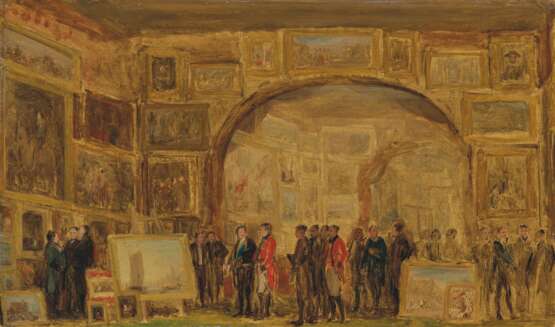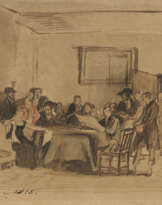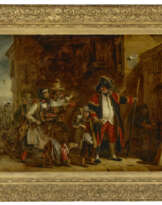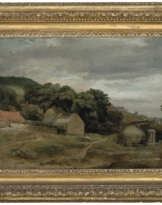ID 737260
Lot 200 | SIR DAVID WILKIE, R.A. (CULTS, FIFE 1785-1841 GIBRALTAR)
Valeur estimée
£ 20 000 – 30 000
An exhibition of old masters at the British Institution
signed and indistinctly dated 'D Wilkie 18...' (on the reverse)
oil on panel
7 x 11 7/8 in. (17.8 x 30.3 cm.)
In this sketch Wilkie has essentially chosen to depict a private view of the British Institution’s loan exhibition of 1815, with some alterations to the pictures displayed. At the centre of the composition two figures stand apart from the group, which can be identified as the Prince Regent in red and the Marquis of Stafford wearing the blue garter sash. Though George III was nominally the Institution’s patron, at this date he was not appearing in public so his duties fell to the Regent, who lent many of his own paintings to the 1815 exhibition. His private visit was reported in The Times, 4 May 1815: ‘His Royal Highness...accompanied by the Duke of Clarence and General Bloomfield, walked to the British Institution, to see the paintings by Rubens, Rembrandt, Vandyke, and other artists of the Flemish and Dutch schools. The Regent was received by the Marquis of Stafford and others of the Directors. He remained in the exhibition near two hours, when he returned to Carlton-house, and took an airing on horseback’. It is not known if Wilkie was in fact present at this private view, but he would undoubtedly have visited the exhibition.
Moving from left to right of the sketch, we can identify van Dyck’s Equestrian Portrait of Charles I (London, National Gallery), lent in 1815 by the Duke of Marlborough. Directly to the right is Rubens’ Judgement of Paris (London, National Gallery), which at this date was in the collection of Thomas Penrice and was not lent to the exhibition; instead, it is likely that Wilkie would have had the opportunity to study in at the time of Lord Kinnaird’s sale in 1813. To the right of this we find St. Ambrose and the Emperor Theodosius by van Dyck (London, National Gallery). Again, this was not lent to the Institution by its then owner John Julius Angerstein, but this and his other painting, Rembrandt’s Christ and the Woman Taken in Adultery (seen here below Charles I) were both lent to the British Institution for artists to study at some point after his acquisition of the work in 1807. On the easel, the main focus of the Prince and Stafford, is a work owned by the latter, Cuyp’s The Landing of Prince Maurice at Dort (Private collection), which was actually exhibited in 1815.
| Artiste: | David Wilkie (1785 - 1841) |
|---|---|
| Technique appliquée: | Huile sur panneau |
| Artiste: | David Wilkie (1785 - 1841) |
|---|---|
| Technique appliquée: | Huile sur panneau |
| Adresse de l'enchère |
CHRISTIE'S 8 King Street, St. James's SW1Y 6QT London Royaume-Uni | |
|---|---|---|
| Aperçu |
| |
| Téléphone | +44 (0)20 7839 9060 | |
| Commission | see on Website | |
| Conditions d'utilisation | Conditions d'utilisation |














